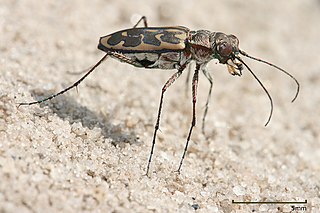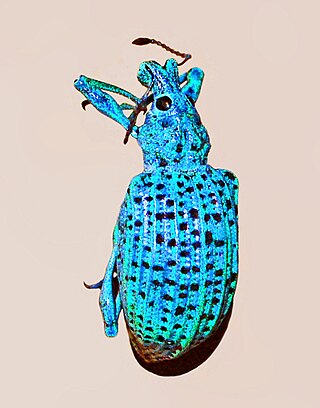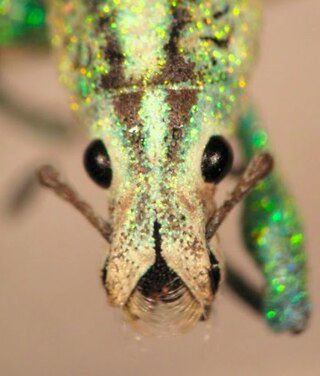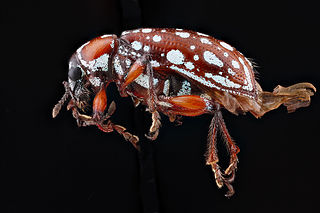| Rhinastus | |
|---|---|
 | |
| Rhinastus sternicornis from Brazil | |
| Scientific classification | |
| Kingdom: | |
| Phylum: | |
| Class: | |
| Order: | |
| Family: | |
| Subfamily: | |
| Tribe: | |
| Subtribe: | |
| Genus: | Rhinastus Schoenherr, 1826 |
Rhinastus is a genus of beetles belonging to the family Curculionidae.
| Rhinastus | |
|---|---|
 | |
| Rhinastus sternicornis from Brazil | |
| Scientific classification | |
| Kingdom: | |
| Phylum: | |
| Class: | |
| Order: | |
| Family: | |
| Subfamily: | |
| Tribe: | |
| Subtribe: | |
| Genus: | Rhinastus Schoenherr, 1826 |
Rhinastus is a genus of beetles belonging to the family Curculionidae.
The species of this genus are generally large and broad weevils, quite flattened, yellowish, with very long beaks and legs and a striking sexual dimorphism.

Tiger beetles are a family of beetles, Cicindelidae, known for their aggressive predatory habits and running speed. The fastest known species of tiger beetle, Rivacindela hudsoni, can run at a speed of 9 km/h, or about 125 body lengths per second. As of 2005, about 2,600 species and subspecies were known, with the richest diversity in the Oriental (Indo-Malayan) region, followed by the Neotropics. While historically treated as a subfamily of ground beetles (Carabidae) under the name Cicindelinae, several studies since 2020 indicated that they should be treated as a family, the Cicindelidae, which are a sister group to Carabidae within the Adephaga.

Pierre François Marie Auguste Dejean, was a French soldier and entomologist. Dejean described a large number of beetles in a series of catalogues.

The flea beetle is a small, jumping beetle of the leaf beetle family (Chrysomelidae), that makes up the tribe Alticini which is part of the subfamily Galerucinae. Historically the flea beetles were classified as their own subfamily.

Zabrus is a genus of ground beetles. They are, unusually for ground beetles, omnivores or even herbivores, and Zabrus tenebrioides can become a pest in cereal fields.

Otiorhynchus is a large genus of weevils in the family Curculionidae. Many species of the genus, particularly the black vine weevil and the strawberry root weevil, are important pests, both as larvae and as adults. Larvae feed on plant roots. Adults are flightless with fused elytra and feed at night on plant foliage. In many species of the genus at least some races are polyploid and parthenogenetic, while the rest of the races and species are diploid and bisexual. Otiorhynchus weevils, particularly O. scaber, have been a popular subject for studies of the evolution of parthenogenesis. The genus is native to the Palearctic region. However, sixteen species were inadvertently introduced to North America and have become widespread there.

Hadramphus, commonly known as knobbled weevils, is a genus of flightless molytine weevils from the family Curculionidae. It is endemic to New Zealand and consists of four species.
Larinus pollinis is a species of cylindrical weevils belonging to the family Curculionidae, subfamily Lixinae.

Rhigus is a genus of beetles belonging to the family Curculionidae.

Rhinastus sternicornis is a species of beetles belonging to the family Curculionidae.

Rhynchophorus, or common name palm weevils, is a genus of beetles in the weevil family, Curculionidae. Palm weevils are major pests of various trees in the family Arecaceae throughout the tropics including: coconut, Areca catechu, species of the genus Phoenix, and Metroxylon sagu. Two species are invasive pests outside their native ranges, Rhynchophorus ferrugineus and Rhynchophorus palmarum.

Cyclocephala is a genus of scarab beetles from the subfamily Dynastinae. Beetles of this genus occur from southeastern Canada to Argentina and the West Indies.

Rhamphini is a weevil tribe in the subfamily Curculioninae.

Geonemini is a weevil tribe in the subfamily Entiminae.
Madarellus is a genus of flower weevils in the family Curculionidae. There are at least 50 described species in Madarellus.

Mecinus is a genus of true weevils in the family of beetles known as Curculionidae. There are at least 90 described species in Mecinus.

Eumolpini is a tribe of leaf beetles in the subfamily Eumolpinae. It is the largest tribe in the subfamily, with approximately 170 genera found worldwide. Members of the tribe almost always have a longitudinal median groove on the pygidium, which possibly helps to keep the elytra locked at rest. They also generally have a subglabrous body, as well as appendiculate pretarsal claws.

Ellescus is a genus of true weevils in the beetle family Curculionidae. There are about 16 described species in Ellescus.

Hylurgus is a genus of beetles belonging to the family Curculionidae.

Oxyderces is a genus of broad-nosed weevils in the family Curculionidae distributed in South America. It can be recognized by the presence of dense setae on the apex of the rostrum and postocular setae.

Lachnopus is a genus of broad-nosed weevils in the family Curculionidae distributed in the Caribbean Region.